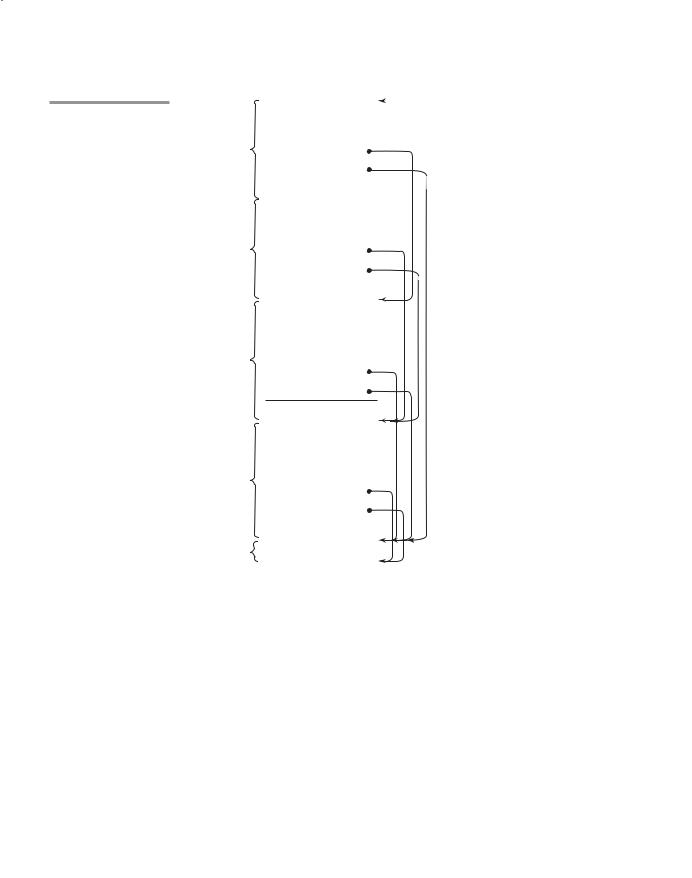
- •New to the Tenth Edition
- •Preface
- •Acknowledgments
- •About the Author
- •Contents
- •1.1 Reasons for Studying Concepts of Programming Languages
- •1.2 Programming Domains
- •1.3 Language Evaluation Criteria
- •1.4 Influences on Language Design
- •1.5 Language Categories
- •1.6 Language Design Trade-Offs
- •1.7 Implementation Methods
- •1.8 Programming Environments
- •Summary
- •Problem Set
- •2.1 Zuse’s Plankalkül
- •2.2 Pseudocodes
- •2.3 The IBM 704 and Fortran
- •2.4 Functional Programming: LISP
- •2.5 The First Step Toward Sophistication: ALGOL 60
- •2.6 Computerizing Business Records: COBOL
- •2.7 The Beginnings of Timesharing: BASIC
- •2.8 Everything for Everybody: PL/I
- •2.9 Two Early Dynamic Languages: APL and SNOBOL
- •2.10 The Beginnings of Data Abstraction: SIMULA 67
- •2.11 Orthogonal Design: ALGOL 68
- •2.12 Some Early Descendants of the ALGOLs
- •2.13 Programming Based on Logic: Prolog
- •2.14 History’s Largest Design Effort: Ada
- •2.15 Object-Oriented Programming: Smalltalk
- •2.16 Combining Imperative and Object-Oriented Features: C++
- •2.17 An Imperative-Based Object-Oriented Language: Java
- •2.18 Scripting Languages
- •2.19 The Flagship .NET Language: C#
- •2.20 Markup/Programming Hybrid Languages
- •Review Questions
- •Problem Set
- •Programming Exercises
- •3.1 Introduction
- •3.2 The General Problem of Describing Syntax
- •3.3 Formal Methods of Describing Syntax
- •3.4 Attribute Grammars
- •3.5 Describing the Meanings of Programs: Dynamic Semantics
- •Bibliographic Notes
- •Problem Set
- •4.1 Introduction
- •4.2 Lexical Analysis
- •4.3 The Parsing Problem
- •4.4 Recursive-Descent Parsing
- •4.5 Bottom-Up Parsing
- •Summary
- •Review Questions
- •Programming Exercises
- •5.1 Introduction
- •5.2 Names
- •5.3 Variables
- •5.4 The Concept of Binding
- •5.5 Scope
- •5.6 Scope and Lifetime
- •5.7 Referencing Environments
- •5.8 Named Constants
- •Review Questions
- •6.1 Introduction
- •6.2 Primitive Data Types
- •6.3 Character String Types
- •6.4 User-Defined Ordinal Types
- •6.5 Array Types
- •6.6 Associative Arrays
- •6.7 Record Types
- •6.8 Tuple Types
- •6.9 List Types
- •6.10 Union Types
- •6.11 Pointer and Reference Types
- •6.12 Type Checking
- •6.13 Strong Typing
- •6.14 Type Equivalence
- •6.15 Theory and Data Types
- •Bibliographic Notes
- •Programming Exercises
- •7.1 Introduction
- •7.2 Arithmetic Expressions
- •7.3 Overloaded Operators
- •7.4 Type Conversions
- •7.5 Relational and Boolean Expressions
- •7.6 Short-Circuit Evaluation
- •7.7 Assignment Statements
- •7.8 Mixed-Mode Assignment
- •Summary
- •Problem Set
- •Programming Exercises
- •8.1 Introduction
- •8.2 Selection Statements
- •8.3 Iterative Statements
- •8.4 Unconditional Branching
- •8.5 Guarded Commands
- •8.6 Conclusions
- •Programming Exercises
- •9.1 Introduction
- •9.2 Fundamentals of Subprograms
- •9.3 Design Issues for Subprograms
- •9.4 Local Referencing Environments
- •9.5 Parameter-Passing Methods
- •9.6 Parameters That Are Subprograms
- •9.7 Calling Subprograms Indirectly
- •9.8 Overloaded Subprograms
- •9.9 Generic Subprograms
- •9.10 Design Issues for Functions
- •9.11 User-Defined Overloaded Operators
- •9.12 Closures
- •9.13 Coroutines
- •Summary
- •Programming Exercises
- •10.1 The General Semantics of Calls and Returns
- •10.2 Implementing “Simple” Subprograms
- •10.3 Implementing Subprograms with Stack-Dynamic Local Variables
- •10.4 Nested Subprograms
- •10.5 Blocks
- •10.6 Implementing Dynamic Scoping
- •Problem Set
- •Programming Exercises
- •11.1 The Concept of Abstraction
- •11.2 Introduction to Data Abstraction
- •11.3 Design Issues for Abstract Data Types
- •11.4 Language Examples
- •11.5 Parameterized Abstract Data Types
- •11.6 Encapsulation Constructs
- •11.7 Naming Encapsulations
- •Summary
- •Review Questions
- •Programming Exercises
- •12.1 Introduction
- •12.2 Object-Oriented Programming
- •12.3 Design Issues for Object-Oriented Languages
- •12.4 Support for Object-Oriented Programming in Smalltalk
- •12.5 Support for Object-Oriented Programming in C++
- •12.6 Support for Object-Oriented Programming in Objective-C
- •12.7 Support for Object-Oriented Programming in Java
- •12.8 Support for Object-Oriented Programming in C#
- •12.9 Support for Object-Oriented Programming in Ada 95
- •12.10 Support for Object-Oriented Programming in Ruby
- •12.11 Implementation of Object-Oriented Constructs
- •Summary
- •Programming Exercises
- •13.1 Introduction
- •13.2 Introduction to Subprogram-Level Concurrency
- •13.3 Semaphores
- •13.4 Monitors
- •13.5 Message Passing
- •13.6 Ada Support for Concurrency
- •13.7 Java Threads
- •13.8 C# Threads
- •13.9 Concurrency in Functional Languages
- •13.10 Statement-Level Concurrency
- •Summary
- •Review Questions
- •Problem Set
- •14.1 Introduction to Exception Handling
- •14.2 Exception Handling in Ada
- •14.3 Exception Handling in C++
- •14.4 Exception Handling in Java
- •14.5 Introduction to Event Handling
- •14.6 Event Handling with Java
- •14.7 Event Handling in C#
- •Review Questions
- •Problem Set
- •15.1 Introduction
- •15.2 Mathematical Functions
- •15.3 Fundamentals of Functional Programming Languages
- •15.4 The First Functional Programming Language: LISP
- •15.5 An Introduction to Scheme
- •15.6 Common LISP
- •15.8 Haskell
- •15.10 Support for Functional Programming in Primarily Imperative Languages
- •15.11 A Comparison of Functional and Imperative Languages
- •Review Questions
- •Problem Set
- •16.1 Introduction
- •16.2 A Brief Introduction to Predicate Calculus
- •16.3 Predicate Calculus and Proving Theorems
- •16.4 An Overview of Logic Programming
- •16.5 The Origins of Prolog
- •16.6 The Basic Elements of Prolog
- •16.7 Deficiencies of Prolog
- •16.8 Applications of Logic Programming
- •Review Questions
- •Programming Exercises
- •Bibliography
- •Index

454 |
Chapter 10 Implementing Subprograms |
10.4 Nested Subprograms
Some of the non–C-based static-scoped programming languages use stack-dynamic local variables and allow subprograms to be nested. Among these are Fortran 95+ Ada, Python, JavaScript, Ruby, and Lua, as well as the functional languages. In this section, we examine the most commonly used approach to implementing subprograms that may be nested. Until the very end of this section, we ignore closures.
10.4.1The Basics
A reference to a nonlocal variable in a static-scoped language with nested subprograms requires a two-step access process. All nonstatic variables that can be nonlocally accessed are in existing activation record instances and therefore are somewhere in the stack. The first step of the access process is to find the instance of the activation record in the stack in which the variable was allocated. The second part is to use the local_offset of the variable (within the activation record instance) to access it.
Finding the correct activation record instance is the more interesting and more difficult of the two steps. First, note that in a given subprogram, only variables that are declared in static ancestor scopes are visible and can be accessed. Also, activation record instances of all of the static ancestors are always on the stack when variables in them are referenced by a nested subprogram. This is guaranteed by the static semantic rules of the static-scoped languages: A subprogram is callable only when all of its static ancestor subprograms are active.1 If a particular static ancestor were not active, its local variables would not be bound to storage, so it would be nonsense to allow access to them.
The semantics of nonlocal references dictates that the correct declaration is the first one found when looking through the enclosing scopes, most closely nested first. So, to support nonlocal references, it must be possible to find all of the instances of activation records in the stack that correspond to those static ancestors. This observation leads to the implementation approach described in the following subsection.
We do not address the issue of blocks until Section 10.5, so in the remainder of this section, all scopes are assumed to be defined by subprograms. Because functions cannot be nested in the C-based languages (the only static scopes in those languages are those created with blocks), the discussions of this section do not apply to those languages directly.
10.4.2Static Chains
The most common way to implement static scoping in languages that allow nested subprograms is static chaining. In this approach, a new pointer, called a static link, is added to the activation record. The static link, which
1. Closures, of course, violate this rule.

10.4 Nested Subprograms |
455 |
is sometimes called a static scope pointer, points to the bottom of the activation record instance of an activation of the static parent. It is used for accesses to nonlocal variables. Typically, the static link appears in the activation record below the parameters. The addition of the static link to the activation record requires that local offsets differ from when the static link is not included. Instead of having two activation record elements before the parameters, there are now three: the return address, the static link, and the dynamic link.
A static chain is a chain of static links that connect certain activation record instances in the stack. During the execution of a subprogram P, the static link of its activation record instance points to an activation record instance of P’s static parent program unit. That instance’s static link points in turn to P’s static grandparent program unit’s activation record instance, if there is one. So, the static chain connects all the static ancestors of an executing subprogram, in order of static parent first. This chain can obviously be used to implement the accesses to nonlocal variables in static-scoped languages.
Finding the correct activation record instance of a nonlocal variable using static links is relatively straightforward. When a reference is made to a nonlocal variable, the activation record instance containing the variable can be found by searching the static chain until a static ancestor activation record instance is found that contains the variable. However, it can be much easier than that. Because the nesting of scopes is known at compile time, the compiler can determine not only that a reference is nonlocal but also the length of the static chain that must be followed to reach the activation record instance that contains the nonlocal object.
Let static_depth be an integer associated with a static scope that indicates how deeply it is nested in the outermost scope. A program unit that is not nested inside any other unit has a static_depth of 0. If subprogram A is defined in a nonnested program unit, its static_depth is 1. If subprogram A contains the definition of a nested subprogram B, then B’s static_depth is 2.
The length of the static chain needed to reach the correct activation record instance for a nonlocal reference to a variable X is exactly the difference between the static_depth of the subprogram containing the reference to X and the static_depth of the subprogram containing the declaration for X. This difference is called the nesting_depth, or chain_offset, of the reference. The actual reference can be represented by an ordered pair of integers (chain_offset, local_offset), where chain_offset is the number of links to the correct activation record instance (local_offset is described in Section 10.3.2). For example, consider the following skeletal Python program:
# Global scope
...
def f1():
def f2():
def f3():

456 |
Chapter 10 Implementing Subprograms |
...
#end of f3
...
#end of f2
...
#end of f1
The static_depths of the global scope, f1, f2, and f3 are 0, 1, 2, and 3, respectively. If procedure f3 references a variable declared in f1, the chain_offset of that reference would be 2 (static_depth of f3 minus the static_depth of f1). If procedure f3 references a variable declared in f2, the chain_offset of that reference would be 1. References to locals can be handled using the same mechanism, with a chain_offset of 0, but instead of using the static pointer to the activation record instance of the subprogram where the variable was declared as the base address, the EP is used.
To illustrate the complete process of nonlocal accesses, consider the following skeletal Ada program:
|
procedure Main_2 is |
|
||||||||
|
|
|||||||||
|
|
X : Integer; |
|
|||||||
|
|
|
procedure Bigsub is |
|
||||||
|
|
|
|
|||||||
|
|
|
|
A, B, C : Integer; |
|
|||||
|
|
|
|
|
procedure Sub1 is |
|
||||
|
|
|
|
|
|
|||||
|
|
|
|
|
|
A, D : Integer; |
|
|||
|
|
|
|
|
|
begin |
-- of Sub1 |
1 |
||
|
|
|
|
|
|
A := B + C; |
||||
|
|
|
|
... |
|
|
||||
|
|
|
|
|
end; |
-- of Sub1 |
|
|||
|
|
|
|
|
|
|||||
|
|
|
|
|
procedure Sub2(X : Integer) is |
|
||||
|
|
|
|
|
|
|||||
|
|
|
|
|
|
B, E : Integer; |
|
|||
|
|
|
|
|
|
|
procedure Sub3 is |
|
||
|
|
|
|
|
|
|
|
|||
|
|
|
|
|
|
|
|
C, E : Integer; |
|
|
|
|
|
|
|
|
|
|
begin -- of Sub3 |
|
|
|
|
|
|
|
|
|
|
... |
|
|
|
|
|
|
|
|
|
|
Sub1; |
|
|
|
|
|
|
|
|
|
|
... |
2 |
|
|
|
|
|
|
|
|
|
E := B + A; |
||
|
|
|
|
|
|
|
end; |
-- of Sub3 |
|
|
|
|
|
|
|
|
|
|
|||
|
|
|
|
|
|
begin |
-- of Sub2 |
|
||
|
|
|
|
... |
|
|
||||
|
|
|
|
|
|
Sub3; |
|
|
||
|
|
|
|
... |
|
3 |
||||
|
|
|
|
|
|
A := D + E; |
||||
|
|
|
|
|
end; |
-- of Sub2 |
|
|||
|
|
|
|
|
|
|||||
|
|
|
|
begin |
-- of Bigsub |
|
||||
|
|
... |
|
|
|
|||||
|
|
|
|
Sub2(7); |
|
|||||
|
|
|
|
|
||||||

10.4 Nested Subprograms |
457 |
...
end; -- of Bigsub begin -- of Main_2
...
Bigsub;
...
end; -- of Main_2
The sequence of procedure calls is
Main_2 calls Bigsub
Bigsub calls Sub2
Sub2 calls Sub3
Sub3 calls Sub1
The stack situation when execution first arrives at point 1 in this program is shown in Figure 10.9.
At position 1 in procedure Sub1, the reference is to the local variable, A, not to the nonlocal variable A from Bigsub. This reference to A has the chain_offset/local_offset pair (0, 3). The reference to B is to the nonlocal B from Bigsub. It can be represented by the pair (1, 4). The local_offset is 4, because a 3 offset would be the first local variable (Bigsub has no parameters). Notice that if the dynamic link were used to do a simple search for an activation record instance with a declaration for the variable B, it would find the variable B declared in Sub2, which would be incorrect. If the (1, 4) pair were used with the dynamic chain, the variable E from Sub3 would be used. The static link, however, points to the activation record for Bigsub, which has the correct version of B. The variable B in Sub2 is not in the referencing environment at this point and is (correctly) not accessible. The reference to C at point 1 is to the C defined in Bigsub, which is represented by the pair (1, 5).
After Sub1 completes its execution, the activation record instance for Sub1 is removed from the stack, and control returns to Sub3. The reference to the variable E at position 2 in Sub3 is local and uses the pair (0, 4) for access. The reference to the variable B is to the one declared in Sub2, because that is the nearest static ancestor that contains such a declaration. It is accessed with the pair (1, 4). The local_offset is 4 because B is the first variable declared in Sub1, and Sub2 has one parameter. The reference to the variable A is to the A declared in Bigsub, because neither Sub3 nor its static parent Sub2 has a declaration for a variable named A. It is referenced with the pair (2, 3).
After Sub3 completes its execution, the activation record instance for Sub3 is removed from the stack, leaving only the activation record instances for Main_2, Bigsub, and Sub2. At position 3 in Sub2, the reference to the variable A is to the A in Bigsub, which has the only declaration of A among the active routines. This access is made with the pair (1, 3). At this position, there

458 |
Chapter 10 |
Figure 10.9
Stack contents at position 1 in the program Main_2
Implementing Subprograms
|
|
|
|
|
|
Top |
|
|
|
Local |
|
|
|
||
|
|
|
|
D |
|||
ARI for |
|
Local |
|
|
A |
||
|
Dynamic link |
|
|
|
|
||
Sub1 |
|
|
|
|
|
||
|
|
|
|
|
|
||
|
|
Static link |
|
|
|
|
|
|
|
|
|
|
|
|
|
|
|
Return (to Sub3) |
|
|
|
||
|
|
|
|
|
|
||
|
|
Local |
|
|
E |
||
ARI for |
|
Local |
|
|
C |
||
|
Dynamic link |
|
|
|
|
||
Sub3 |
|
|
|
|
|
||
|
|
|
|
|
|
||
|
|
Static link |
|
|
|
|
|
|
|
|
|
|
|
|
|
|
|
Return (to Sub2) |
|
|
|
||
|
|
|
|
|
|
||
|
|
Local |
|
|
E |
||
|
|
Local |
|
|
B |
||
ARI for |
|
Parameter |
|
|
X |
||
Sub2 |
|
Dynamic link |
|
|
|
|
|
|
|
|
|
|
|
|
|
|
|
Static link |
|
|
|
|
|
|
|
Return (to Bigsub) |
|
|
|
||
|
|
|
|
|
|
||
|
|
Local |
|
|
C |
||
|
|
Local |
|
|
B |
||
ARI for |
|
Local |
|
|
A |
||
|
|
|
|
||||
Bigsub |
|
Dynamic link |
|
|
|
|
|
|
|
|
|
|
|
|
|
|
|
Static link |
|
|
|
|
|
|
|
|
|
|
|
|
|
|
|
Return (to Main_2) |
|
|
|
||
ARI for |
|
|
|
|
|
|
|
|
Local |
|
X |
||||
Main_2 |
|
|
|||||
|
|
|
|
|
|
||
ARI = activation record instance |
|||||||
|
|||||||
is no visible scope containing a declaration for the variable D, so this reference to D is a static semantics error. The error would be detected when the compiler attempted to compute the chain_offset / local_offset pair. The reference to E is to the local E in Sub2, which can be accessed with the pair (0, 5).
In summary, the references to the variable A at points 1, 2, and 3 would be represented by the following points:
•(0, 3) (local)
•(2, 3) (two levels away)
•(1, 3) (one level away)

10.4 Nested Subprograms |
459 |
It is reasonable at this point to ask how the static chain is maintained during program execution. If its maintenance is too complex, the fact that it is simple and effective will be unimportant. We assume here that parameters that are subprograms are not implemented.
The static chain must be modified for each subprogram call and return. The return part is trivial: When the subprogram terminates, its activation record instance is removed from the stack. After this removal, the new top activation record instance is that of the unit that called the subprogram whose execution just terminated. Because the static chain from this activation record instance was never changed, it works correctly just as it did before the call to the other subprogram. Therefore, no other action is required.
The action required at a subprogram call is more complex. Although the correct parent scope is easily determined at compile time, the most recent activation record instance of the parent scope must be found at the time of the call. This can be done by looking at activation record instances on the dynamic chain until the first one of the parent scope is found. However, this search can be avoided by treating subprogram declarations and references exactly like variable declarations and references. When the compiler encounters a subprogram call, among other things, it determines the subprogram that declared the called subprogram, which must be a static ancestor of the calling routine. It then computes the nesting_depth, or number of enclosing scopes between the caller and the subprogram that declared the called subprogram. This information is stored and can be accessed by the subprogram call during execution. At the time of the call, the static link of the called subprogram’s activation record instance is determined by moving down the static chain of the caller the number of links equal to the nesting_depth computed at compile time.
Consider again the program Main_2 and the stack situation shown in Figure 10.9. At the call to Sub1 in Sub3, the compiler determines the nesting_depth of Sub3 (the caller) to be two levels inside the procedure that declared the called procedure Sub1, which is Bigsub. When the call to Sub1 in Sub3 is executed, this information is used to set the static link of the activation record instance for Sub1. This static link is set to point to the activation record instance that is pointed to by the second static link in the static chain from the caller’s activation record instance. In this case, the caller is Sub3, whose static link points to its parent’s activation record instance (that of Sub2). The static link of the activation record instance for Sub2 points to the activation record instance for Bigsub. So, the static link for the new activation record instance for Sub1 is set to point to the activation record instance for Bigsub.
This method works for all subprogram linkage, except when parameters that are subprograms are involved.
One criticism of using the static chain to access nonlocal variables is that references to variables in scopes beyond the static parent cost more than references to locals. The static chain must be followed, one link per enclosing scope
